Mehrangarh Fort above the blue city of Jodhpur, with its massive structure and thick walls, looks like an indomitable fort standing tall on an almost perpendicular cliff for over five centuries. Built-in red sandstone, this formidable and one of India’s largest forts gives an impression that “you are being watched” from up there. That feeling often makes the structure seem mightier and haunting at times. It is truly the Citadel of Sun that has a glorious past reflecting Rajputs’ valour and the occasional dark secrets hidden behind the lofty walls. A visit to Mehrangarh Fort and the museum had always been on the bucket list of travellers visiting India.
“A palace that might have been built by Titans and coloured by morning sun”
– Rudyard Kipling
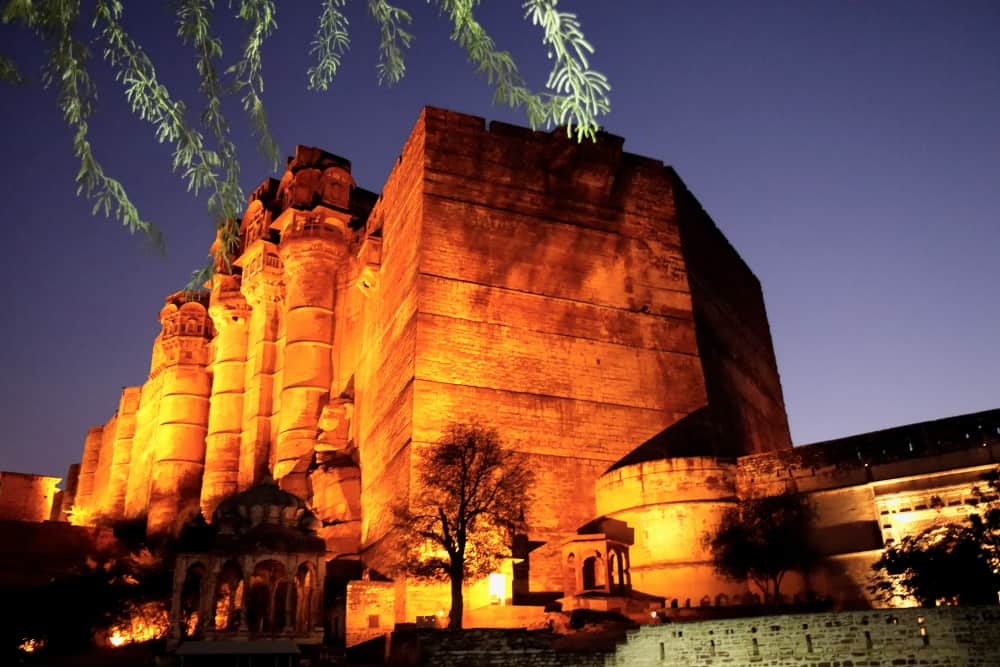
History of Mehrangarh Fort
Rao Jodha, a ruler from the Marwar Kingdom, built Mehrangarh Fort. He shifted the capital from Mandore to Jodhpur in 1459 and built the fort over the hill, 400 feet above from surrounding plains.
In 1438, on the night of Diwali, Rao Ranmal, Rao Jodha’s father, was killed in Chittor Palace by the men of Prince Chunda, the son of the Late Rana Lakha Singh. Ranmal’s own queen Bharmali was a part of this conspiracy. Invited by her sister Hansa Bai, the queen grandmother of Rana Kumbha, Rao Ranmal was also taking care of the Mewar Kingdom and young Rana Kumbha after Rana Mokal Singh’s assassination for a brief period of time until he got killed.
Following his father’s death, young Rao Jodha, who was living in Chittor with his father, was able to escape from Chittor with the help of his fellow countrymen. But he could not get back to Mandore because it already came under the control of the Mewar kingdom after the death of Rao Ranmal. So Rao Jodha hid in villages near Bikaner, and for the next 15 years, he made several unsuccessful attempts to capture Mandore. In 1453, when Rana Kumbha was busy fighting the sultans of Malwa and Gujrat. Jodha was finally able to get control of Mandore.
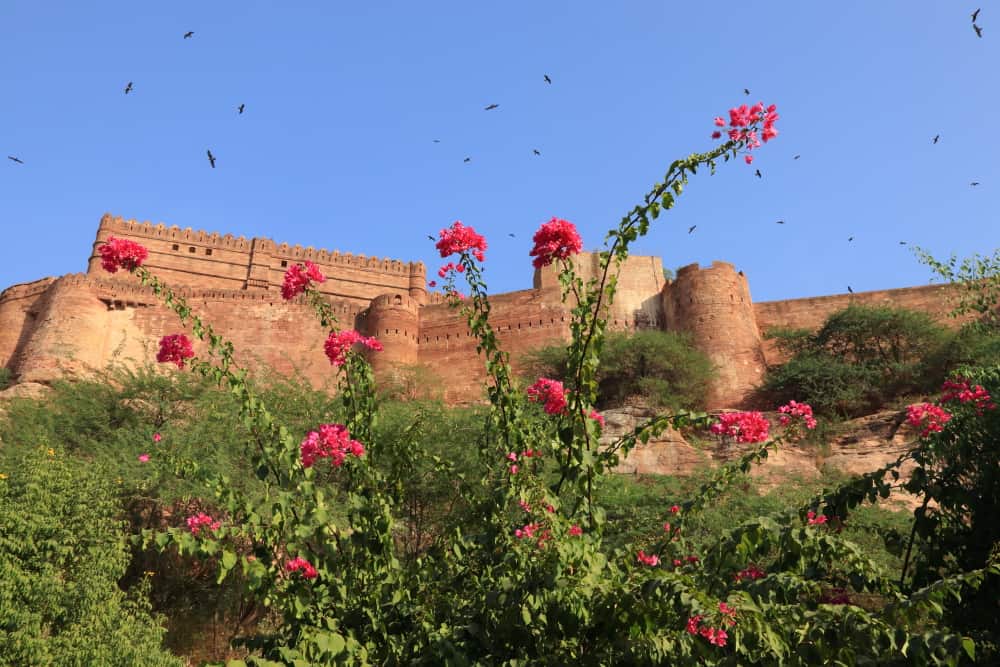
But this frequent battle with Mewar and the occasional encroachment from Delhi Sultanate made Rao Jodha shift his capital to a more strategically advantageous position, on a hilltop nine kilometres south of Mandore. The hill was known as Bhakurcheeria, the mountain of birds. To lay the foundation of his fort, Jodha had to displace the hill’s sole occupant, a hermit named Cheeria Nath Ji, who was very influential among the local population.
After repeated requests from the king, Cheeriya Nath Ji denied moving. So, Rao Jodha asked Karni Mata of Deshnoke for help, a saint with superior power. Seeing a superior power in front, Cheeriya Nath Ji moved out of the hill but cursed the Kingdom, always facing scarcity of water. Rao Jodha managed to control Cheeriya Nath Ji’s anger by promising him to build a house and a temple beside the fort. And eventually, Jodha, with the help of Karni Mata, laid the foundation of the fort.
But the story did not end there. The king needs to sacrifice human life to ensure that Cheeriya Nath Ji’s curse gets negated and the new place brings good luck to the kingdom. That is when Raja Ram Meghwal came and agreed to sacrifice himself for the kingdom, provided the dynasty would look after his heirs. Thus eventually, the construction of the fort was started. Rajaram Meghwal has been regarded as an eternal martyr since then, and his successors have been taken care of till now.
Why it is called Mehrangarh Fort
You will find so many forts in Rajasthan, but only one with a name that is not directly connected to its founder.
The Rathores think of them as a descendant of the Sun God and thus named the fort as Mehrangarh Fort. The word Mihir means Sun, and Garh means Fort. But the local Rajasthani pronunciation calls it Mehrangarh instead of Mihirgarh. This is the explanation I came to know from different sources, which does not look very convincing.
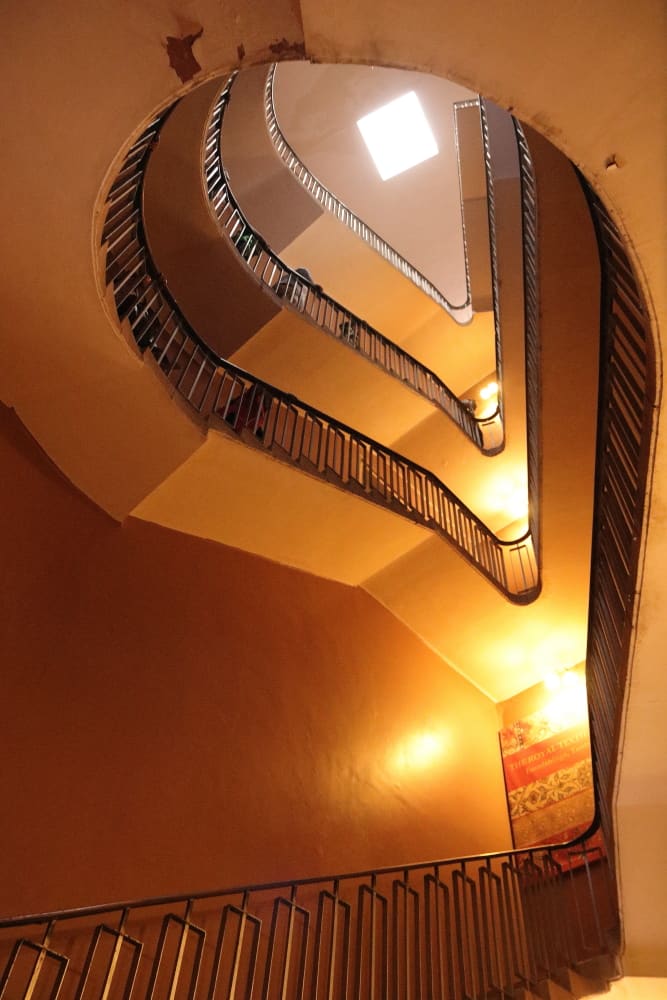
The word “mehr” means full moon or like sun though the word is of Arabi origin.
There is another word, “mehran”, which means “being kind”, like the sacrifice of Raja Ram Meghwal, which eventually made this fort stand there. A dark secret that the subsequent Marwar rulers never tried to hide and always took care of the family of the eternal martyr.
Mehrangarh Fort Architecture
Although Rao Jodha laid the foundation in 1459, the palaces were built over 500 years by different rulers. And different parts of the fort represent a different era. When you walk through the gates and corridors, you can notice the abrupt change in architecture, reflecting a deep-rooted history hidden behind those walls.
There were two significant eras of building the fort in these 500 years. The first period was during Rao Maldeo (1531-1562), and the second time was during Maharaja Ajit Singh (1707-1724).
The fort was attacked by Emperor Sher Shah Suri in 1544 and was captured for a year. Later, when Rao Maldeo recovered the fort from him, he strengthened the walls and the fort’s exterior so that such incidents never got repeated.

Maharaja Ajit Singh built the Daulat Khana, Sheesh Mahal, Fateh Pol and Loha Pol (part of it). Fateh Pol was built in memory of the guerilla war by the leadership of Durgadas Rathore for 25 years, which eventually freed the Marwar Kingdom from the rule of Aurangzeb.
Maharaja Abhay Singh (son of Ajit Singh) built Phool Mahal. And Maharaja Man Singh, who was the ruler of the kingdom when it entered a treaty relationship with the British and called as a princely state, built the Jai Pole. Maharaja Takhat Singh built Takhat Niwas in the later part of the nineteenth century.
The initial foundation and the exterior of the fort were built with minimal artwork where the safety of the palace was the main concern. But as Raja Udai Singh, the first Marwar ruler gifted the title of Raja by Mughals, entered into a relationship with Emperor Akbar by giving the hand of her daughter to Prince Jahangir, the architecture of the Mehrangarh Fort also started to reflect a Mughal style of art and architecture inside the palaces in following years.

The Entrance to the Fort
The entry to the fort is gained through seven large stone gates. Some of them signified a major event associated with the rule of the Marwar Kingdom.
Jai Pol (Victory Gate)
Maharaja Man Singh built this gate to celebrate the victory of the kingdom over Jaipur and Bikaner. The war was fought on the reason of marrying the princess of Udaipur – Krishna Kumari, who eventually took her life by poisoning herself at the age of 16 years to end a series of wars that lasted for nearly seven years involving the state of Jaipur, Jodhpur, Bikaner, Tonk, Udaipur, Scindias and Marathas.
Just outside this gate, you will notice a chhatri constructed in memory of Kirat Singh Soda, who fell at that place while defending the fort.
Fateh Pol (Victory Gate)
Another victory gate was built in the early eighteenth century. Fateh Pol was built by Raja Ajit Singh in 1707 to celebrate victory over the Mughals (the year Aurangzeb died and Durgadas Rathore, the minister of Ajit Singh, reclaimed control of Jodhpur).

Dedh Kangra Pol
Dedh Kangra Pol’s significance was imprinted on its walls. There are marks of cannonballs that hit this gate during the war with the Jaipur army in 1807. The memorial of Raja Ram Meghwal, the eternal martyr of Mehrangarh Fort, is also beside this gate.
Rao Maldeo built Dedh Kangra Pol or Lakhan Pol. Next to this gate is Amriti Pol, which H.H. Maldeo also built. After defending the fort from Sher Shah’s invasion, he built three gates that included part of Loha Pol.
Loha Pol (Iron Gate)
Loha Pol is the last gate before entering the courtyard by taking a sharp bend to the right. You will see musicians playing near this gate. There are imprints of the hands of queens of the Marwar Kingdom who committed Sati, including the queens of Raja Ajit Singh.
Courtyards
Finally, turning through Loha Pol will make you enter the main courtyard – The Shringar Chowk. The moment you reach Shingar Chowk, you will be surrounded by buildings and palaces all around. A chair made of marble rock is in one corner, which was used for the coronation of a new king. And then there are many doorways around. You will also notice Rajput men with long moustaches and in traditional Rajasthani dresses demonstrating how to tie a turban.
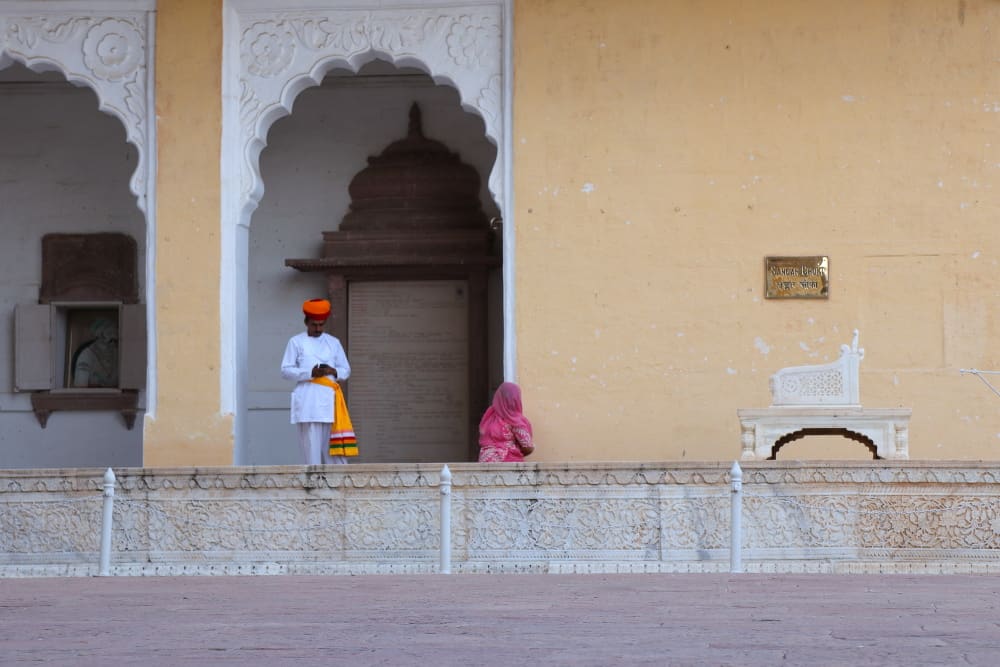
A stairway from the courtyard goes up to the upper floor, and a door at the floor opens to the basement, both of which are inaccessible to visitors. There is a cafe around the corner. The main doorway to the Durbar (the court) is the Suraj Pol, through which tourists have to enter the gallery of howdahs and palanquins. And the visit to Mehrangarh Fort museum will start. You can explore several galleries on the same floor with more period rooms upstairs until you end the tour by exiting through Zenana Gate.
Visit to Mehrangarh Fort museum
There is a total of seven-period rooms and six galleries inside Mehrangarh Fort Museum. The period rooms are –
- Sheesh Mahal
- Phool Mahal
- Takhat Vilas
- Sardar Vilas
- Jhanki Mahal
- Dipak Mahal
- Moti Mahal
And the six galleries are –
- Howdah Gallery
- Palanquin Gallery
- Daulat Khana
- Painting Gallery
- Textile Gallery
- Arms Gallery
Let’s visit these rooms one by one in the same order I went through them during my visit.
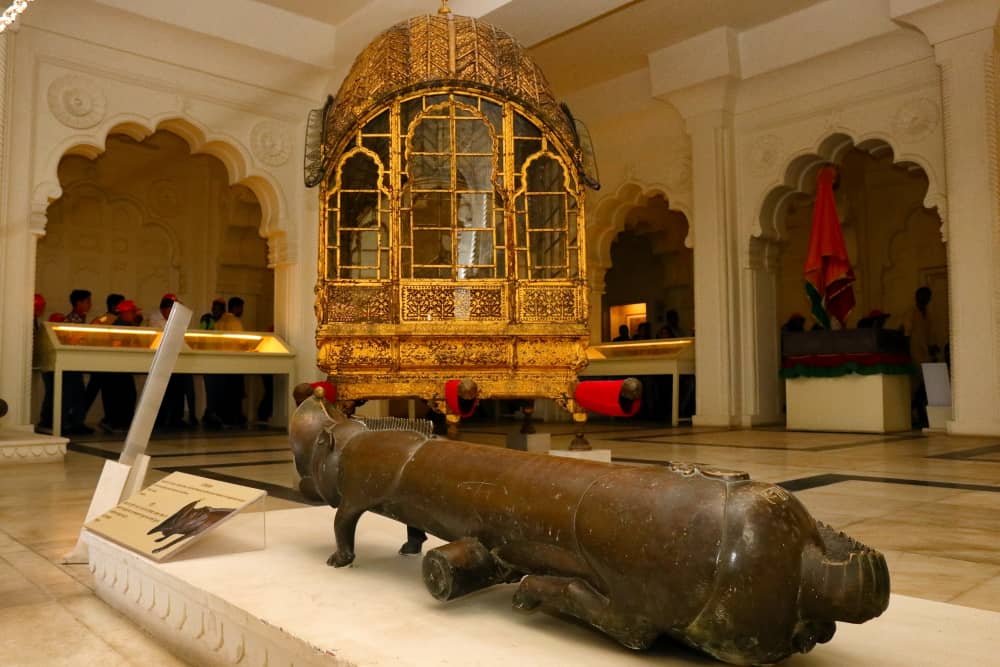
Howdah Gallery
If you don’t know what a howdah is, it is a seat used by kings to sit on the back of an elephant. The howdahs used by Marwar kings are displayed here. All of them are decorated with silver artwork. And Emperor Shahjahan gifted the best of all to Maharaja Jaswant Singh.
Palanquin Gallery
Palanquins or palki were frequently used by royal women until the mid-twentieth century to hide behind the veil during transport. Some exquisite pieces of palanquines made of wood and metal and decorated with ivory, gold, silver and precious stones are displayed in this gallery.
Daulat Khana
Daulat Khana, or treasury room, is the museum’s most important and preserved gallery. You can see a collection of artworks from a period when Rathore kings were closely related to Mughal emperors.
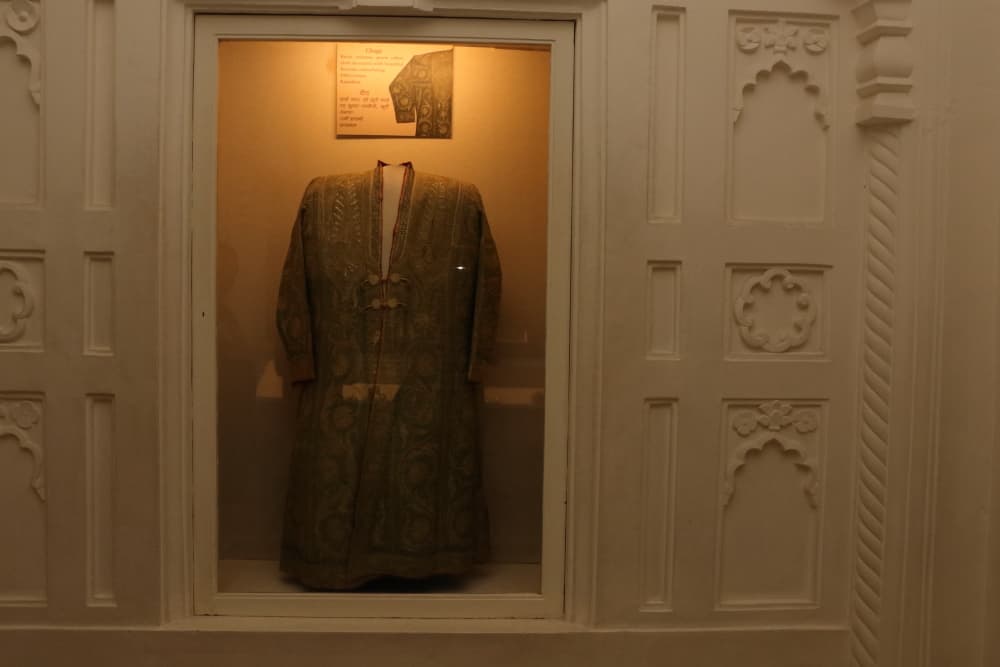
Painting Gallery
The painting gallery displays miniature paintings from the Marwar kingdom. Court painting developed greatly during the association of Rajput rulers with the Mughals in the 17th century. In the later period, the painting style, mixed with the Rajasthani folk style, gradually matured into a distinct Marwar art that you can see in a dozen paintings of Maharaja Man Singh, his nobles and ladies.
Textile Gallery
Textile and Arms gallery is near the stairs that take you to the upper levels. In the textile gallery, you can see gorgeous and colourful clothes used by royal members during vacations and pilgrimages. You can also see precious carpets, colourful work of embroideries, brocades, and velvets that gives an opportunity to look back at the grandeur of the Marwar kingdom. There is also a display of tents used by kings during the war.
Arms Gallery
Rajput kings are known for their bravery and war tactics. The Selaihkhana, or the Arms and Armour Gallery, showcases the weapons, helmets, and shields used by the Rathore kings. This exhibition highlights stunning examples of watered steel blades, hilts embellished with gold and silver works, masterfully crafted daggers and dagger blades, and rare examples of shields decorated with leatherwork.
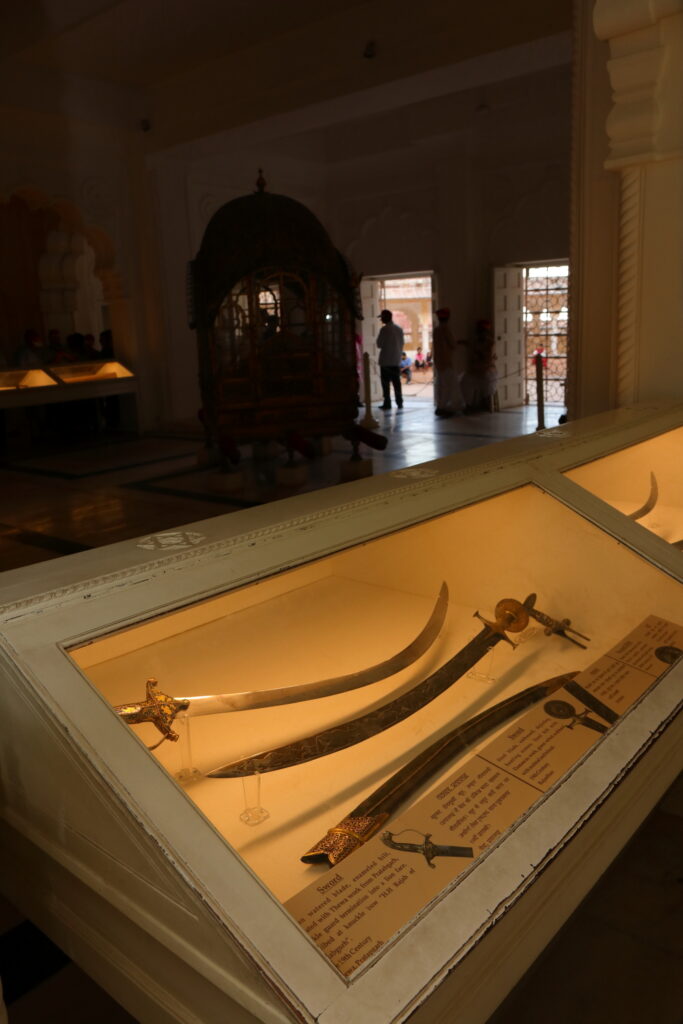
Sheesh Mahal
Sheesh Mahal, or Palace of Mirrors, was used as the bedroom of Maharaja Ajit Singh. It is decorated with wonderful glasswork on the roof and over the walls. There is a gesso panel of paintings of the Hindu gods and goddesses just beneath the roof’s arches. The wooden ceiling and the European glass chandler on it are a later addition after the original one collapsed, which can be seen lying on the floor.
Phool Mahal
Phool Mahal, or the Palace of Flowers, is a gorgeous private chamber full of grandiosity. It was built by Maharaja Abhay Singh and was used as a private chamber for celebrations and meetings.
The gilded ceiling, the carpeted floor, the glass panels on the wall, and the use of bright colours everywhere only indicate the glamour and glitz of royal life in the mid-eighteenth century.
Takhat Vila
This was the bedroom of Maharaja Takht Singh. The room has ceiling-to-floor paintings of Hindu gods and goddesses to European ladies. The carpet on the floor is also painted in this room. The windows are also covered with colourful glass panels. This room is probably the largest period room in the museum.
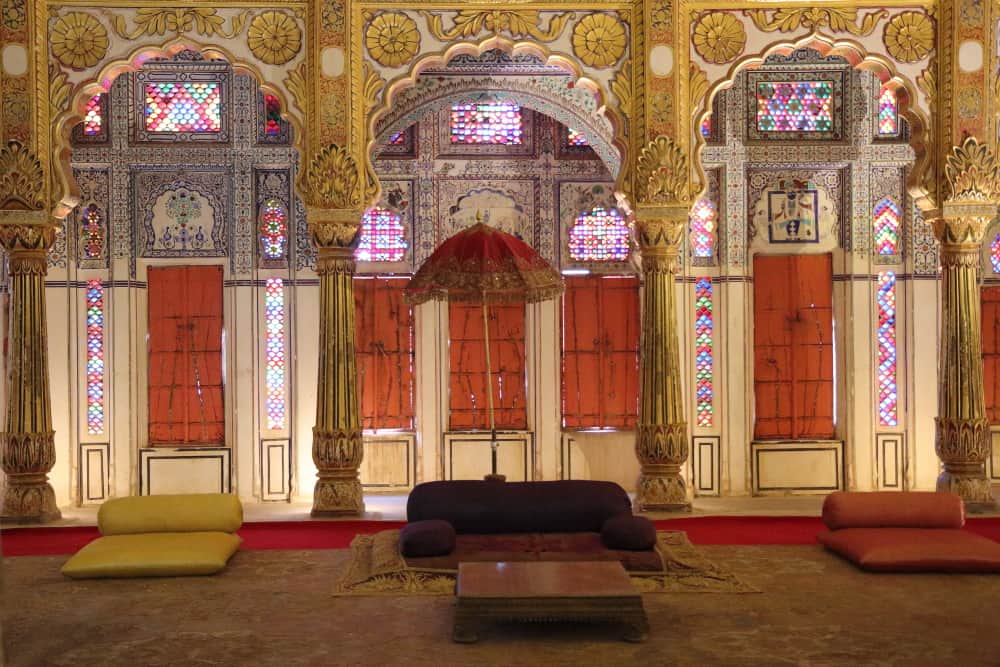
Sardar Vila
This is an 18th-century palace room that underwent renovations many times. There is a display of doors and windows which are once part of Mehrangarh Palace.
Jhanki Mahal
Maharaja Takht Singh also built the Jhanki Mahal. It was constructed to allow royal women to witness proceedings in the courtyard. The jaalis and small windows allow them to see the celebrations below without being observed. This chamber displays cradles or swings that were once used for infants and family deities on festival days.
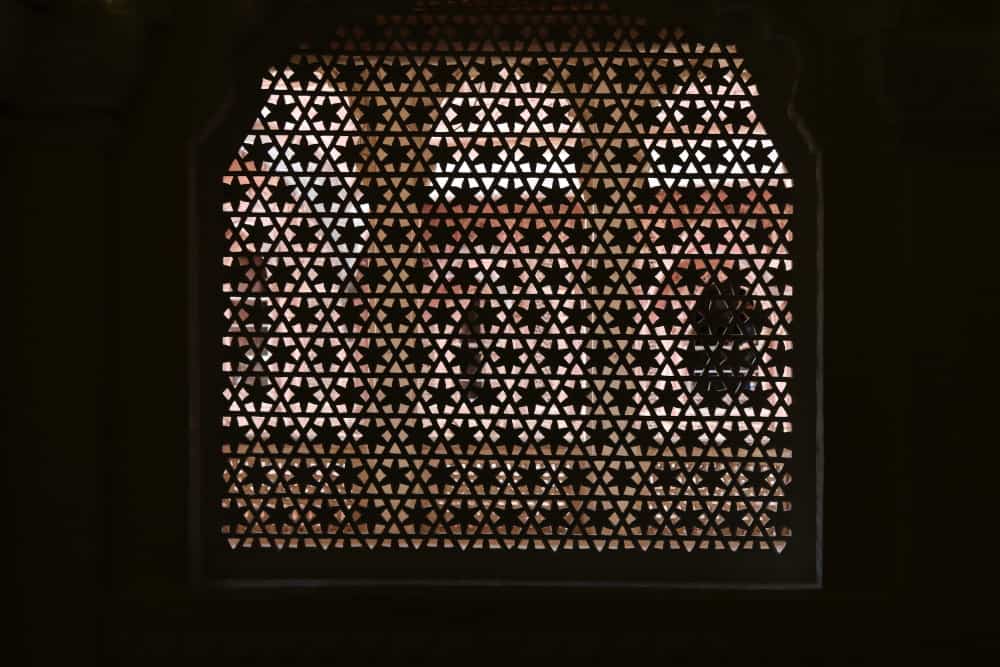
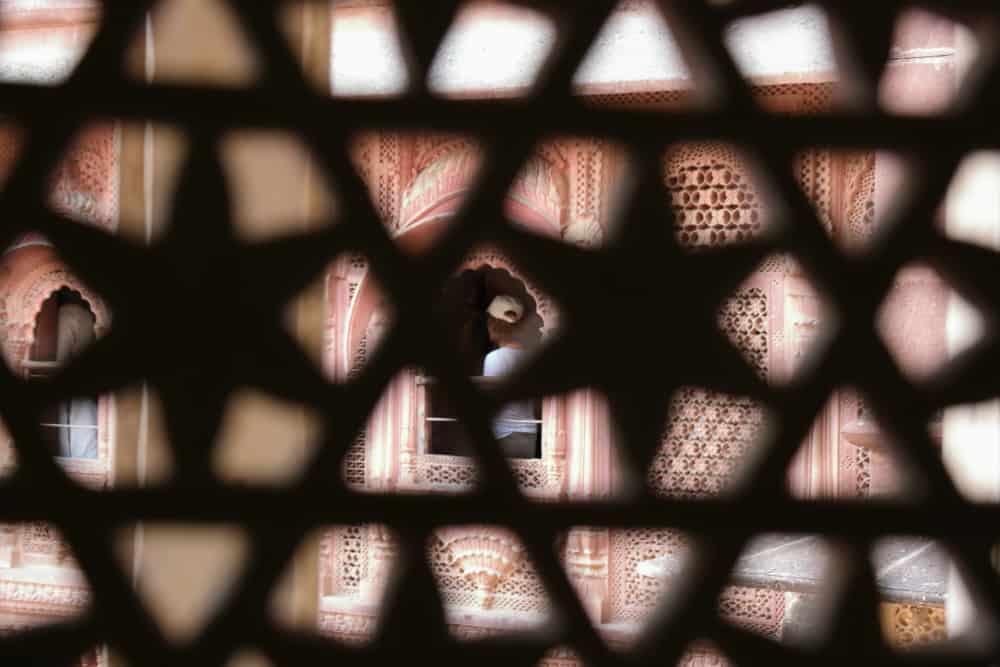
Dipak Mahal
Dipak Mahal was once part of a courtyard and was built by Maharaja Ajit Singh to meet with his subordinates for administrative work. Maharaja occupied the seat at the back while other officials sat on the floor.
Moti Mahal
Moti Mahal, or the Pearl Palace, is the oldest period room in the fort. Raja Sur Singh built it as a hall for the public audience. The use of lime plaster with a crushed shell gives colour to the room like a pearl. The ceiling is embellished with mirror and gold.
Temples in the Fort
Chamunda Mataji temple
Chamunda Mata is the family deity of the royal family. The idol was brought from Mandore by Rao Jodha and was installed here in 1460. The temple is located at the southern end of Mehrangarh Fort. The temple was severely damaged by an explosion in the fort and was rebuilt by Maharaja Takhat Singh in 1857.
Devi Chamunda Mataji, one of the many forms of Maa Shakti or Goddess Durga, is also worshipped by the general people of Jodhpur. A huge mass gathers here every year during Dussehra to pay respect and offer prayers.
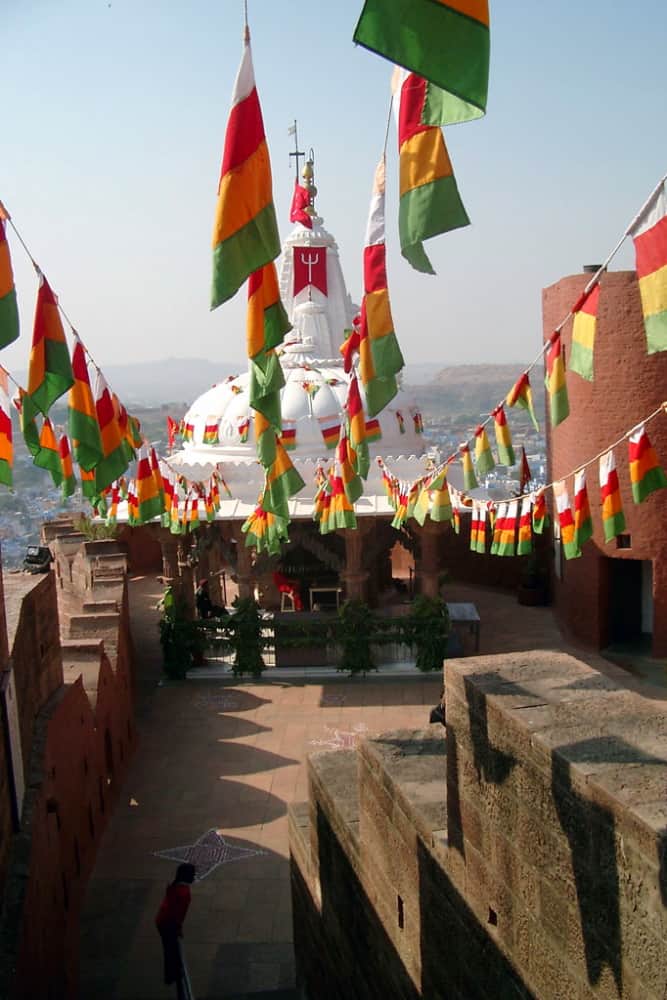
Nagnechiji temple
Nagnechiji temple is the family temple of Rathores. Rao Doohad, the 3rd ruler of the Rathore clan, brought this idol to the family in the early 14th century and installed it later in Mehrangarh Fort.
How to reach Mehrangarh Fort from Jodhpur Town
Mehrangarh Fort is in Jodhpur, Rajasthan. To reach Jodhpur, you can take a flight to Jaipur International Airport and catch a train or a bus from Jaipur to Jodhpur. You can also hire a cab from Jaipur to reach Mehrangarh Fort.
There are also a few direct flights from Delhi and Mumbai to Jodhpur Aiport, and you can take one too if you want to bypass the road or rail journey.
From Jodhpur town, there are two ways to reach Mehrangarh Fort.
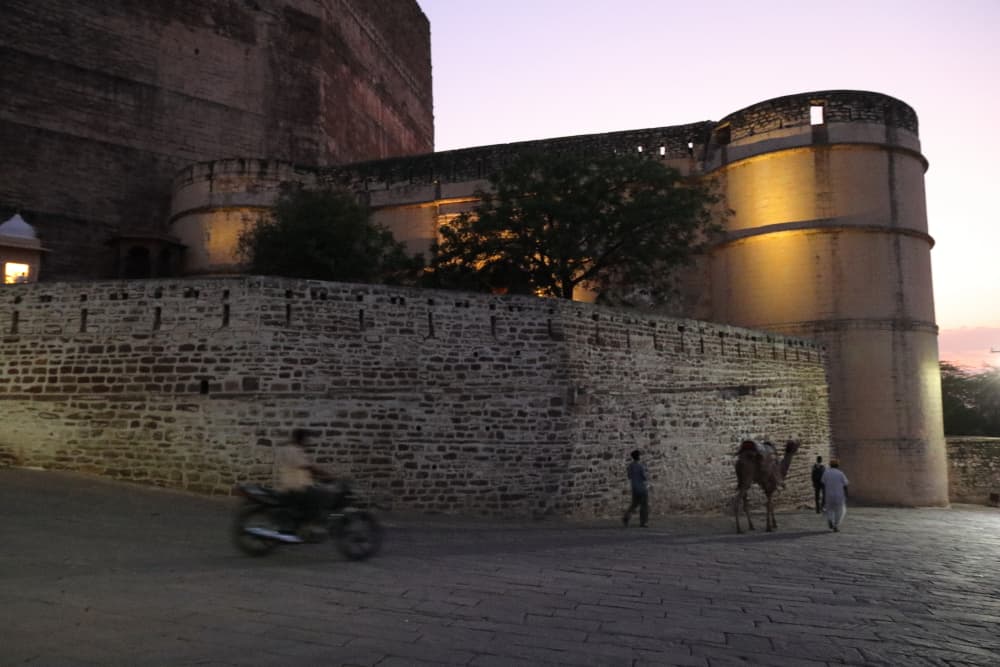
By Car
You either take a cab or an autorickshaw to reach the fort, which is a little above ten kilometres from town. This route takes around thirty minutes to reach the parking in front of the fort. Tourists usually take this road to get there. You can also visit Jaswant Thada on your way or while returning from the fort.
By Walk
You can also walk from the northwest end near Navcowkiya and take the paved slope used by the Fort’s staff and often by locals. You have to enter through another gate to the fort – Chand Pol. It takes around 20 minutes to reach the palace by this route. I loved this backside walkway as it was empty. I was walking back to the old days in my mind until I saw occasional school kids whose families lived inside the fort.
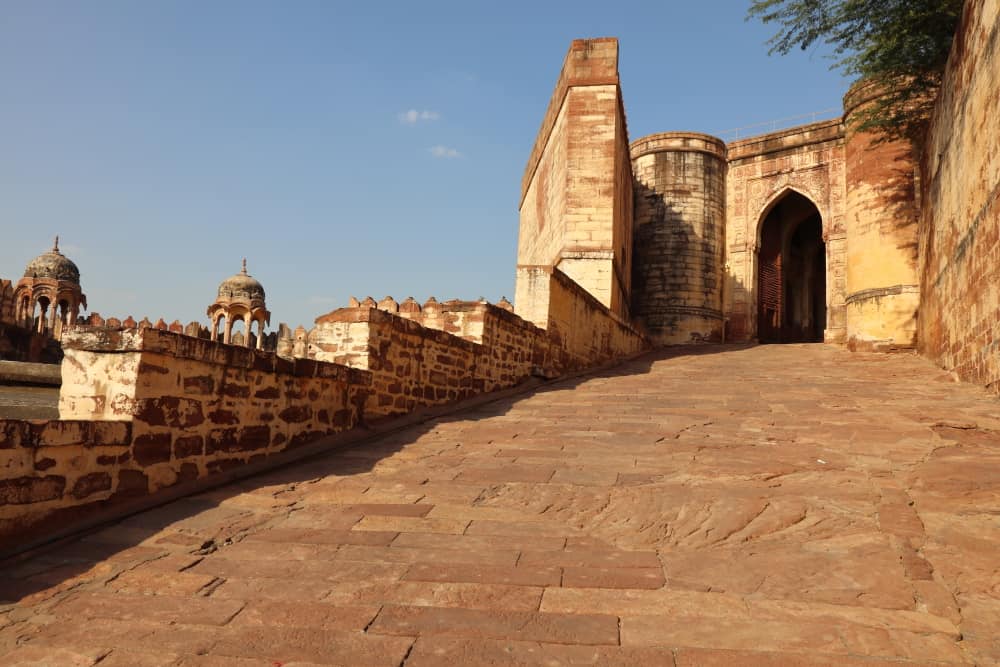
Entry Fee of Mehrangarh Fort Museum and other necessary information
Entry Time
9 am – 5 pm, every day
Entry Ticket:
- International tourists – 600
- International tourist (student) – 400
- Domestic tourists – 150
- Domestic tourists (student, senior citizen) – 100
- Elevator charge (one way) – 50
All entries are free on Jodhpur Foundation Day, 12th May every year. Only an elevator charge is applicable.
You can book your entry tickets online.
Guide Charge:
- 1-4 people – 500
- 5-15 people – 600
- 16-30 people – 800
- 31-50 people – 1000
- Audio guide – 180
- Audio guide (student, senior citizen) – 120
The Audio guide charge for international tourists is included in their entry ticket.
Parking Charge
- Two-wheeler – 10
- Auto-rickshaw – 10
- Car / Jeep – 50
- Mini-bus – 80
- Bus – 100
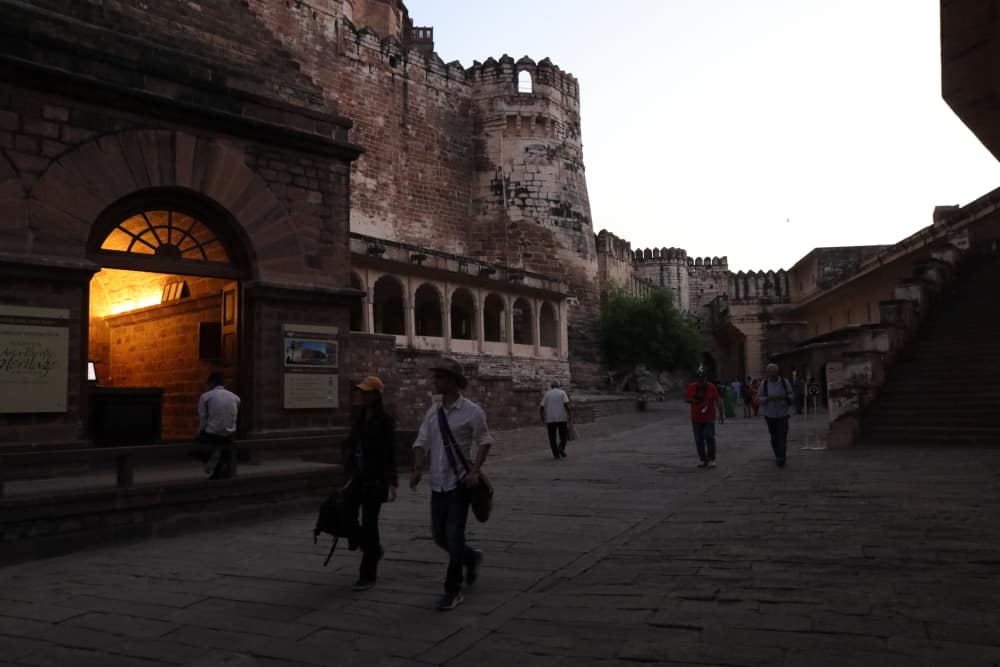
Best Time to visit
The best time to visit Mehrangarh Fort is during winter (November – February), as the city is situated at the periphery of the Thar Desert. It would be better to check the dates of the music festivals and plan accordingly if you want to experience Mehrangarh Fort differently.
You can also visit Jodhpur during monsoon when there is no rush and hotels offer discounts. Jodhpur receives moderate rainfall, and the temperature range between 24°C to 38°C in monsoon. You can soak in the beauty of Mehrangarh Fort at your own pace.
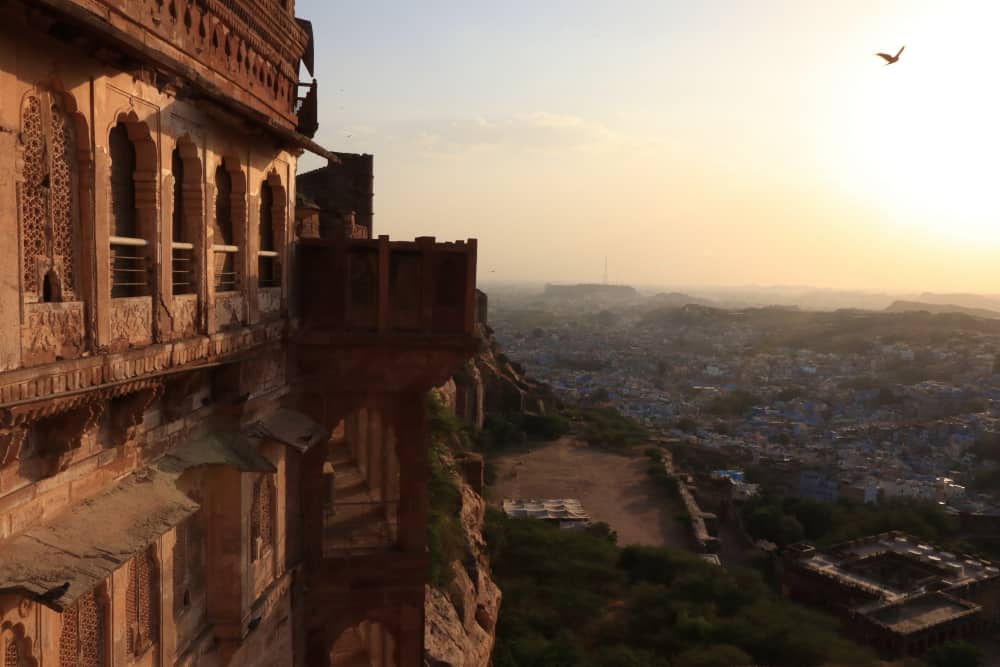
Cafes and Restaurants inside Fort
Cafe Mehran
The museum cafe, or Cafe Mehran, is decorated to reflect the ambience and the period of Mehrangarh Fort. Situated in the inner courtyard, this cafe has the option for light meals and snacks. The prices are affordable, considering you are eating inside a fort that is more than 500 years old.
Time: 9 am – 6 pm (All Days)
Palki Cafe
Palki Cafe is another small cafe beside the path between Jai Pol and Dedh Kangra Pol. The seating arrangement is in an open space, like a nice little family hangout beside the fort’s lofty walls. It is a self-service cafe with a pay before-you-eat option.
Time: 9 am – 6 pm (All Days)
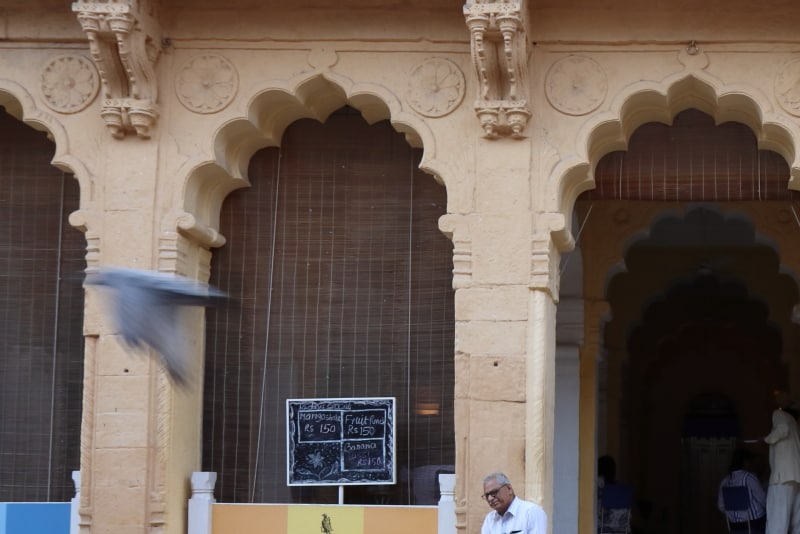
Vaara Cafe
This is a recent addition situated near Zenana Gate, the exit gate from the museum. Tourists can enjoy a nice drink (non-alcoholic) here, sitting in their lounge after the museum’s audio tour is over.
Time: 10 am – 7 pm (All Days)
Chokelao Mahal Terrace Restaurant
This plush restaurant, situated within fort walls, serves traditional Rajasthani food. Guests can enjoy the view of Mehrangarh Fort at night and the city’s skyline while enjoying dinner. There is a pickup facility for guests from the entrance of the fort.
Time: 7 pm – 10:30 pm for dinner
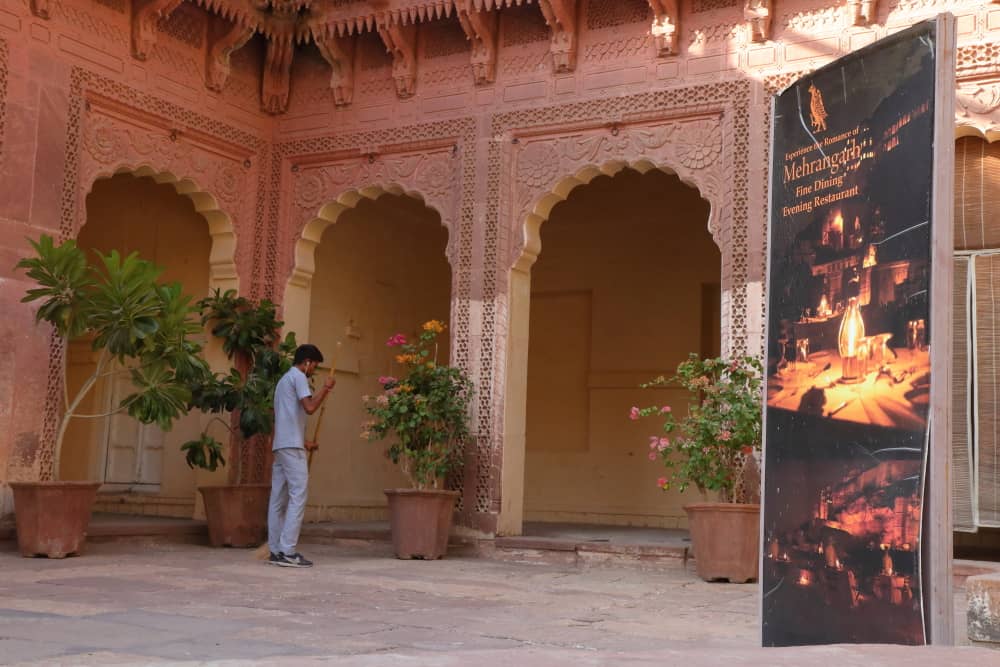
Gift and Souvenir shop in the Fort
The Mehrangarh Museum Shop is the only professional museum store in India. This shop is a fully accredited member of the International Museum Store Association. Any purchase from here supports the conservation and restoration of Mehrangarh and Nagaur forts.
This shop is located near the exit of the museum. So, once you complete your tour, you can visit there to check out the collections. You will find printed T-shirts, caps, bags, books, jewellery pieces, postcards and books.
You can also collect the products by shopping online.

Festivals in Mehrangarh Fort
Jodhpur Rajasthan International Folk Festival (RIFF)
Jodhpur RIFF is a non-profit music festival held annually in Mehrangarh Fort to promote traditional folk music and art. UNESCO endorses the festival as a “People’s Platform for Creativity and Development”.
This festival is held annually around “Sharad Purnima”, which usually falls in October/November. His Highness Maharaja Gaj Singh II is the chief patron of this festival, whereas Sir Mick Jagger, the leading member of Rolling Stones, is the international patron.
Dates for 2023: Thu, 26 Oct, 2023 – Mon, 30 Oct, 2023
Sacred Spirit Festival
Sacred Spirit Festival is one of the leading music festivals in the world. The festival was initially started in Ahhichatragarh Fort in Nagaur, and later Mehrangarh Fort also started to host part of this festival. Performances are held inside Nagaur Fort for initial three days and then moved to Mehrangarh Fort, where it is staged near Jaswant Thanda Temple, by the Ranisar Lake or on the rampant of the Mehrangarh Fort.
The festival is usually held in February and see visitors from all over the world.
Dates for 2023:
- Jodhpur Session: 10th February – 12th February
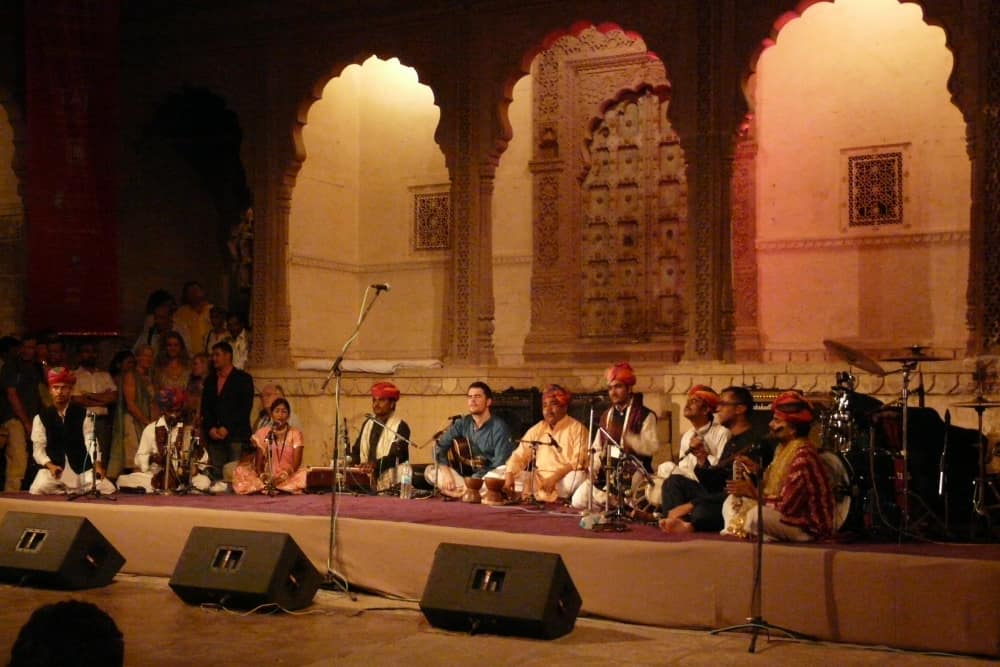
Travel Tips
- It usually takes 4 hours to visit the fort comfortably.
- Outside food is not allowed; it has to be left near the entry.
- The elevator only helps you reach the entrance to the museum. You have to come down on your own.
- Take a guide near the entry ticket counter; you can also opt for an audio guide available in several languages.
- You have to walk a lot, so dress accordingly.
- If you love adventure, you can try the Mehrangarh Fort’s zipline tour by “Flying Fox”.
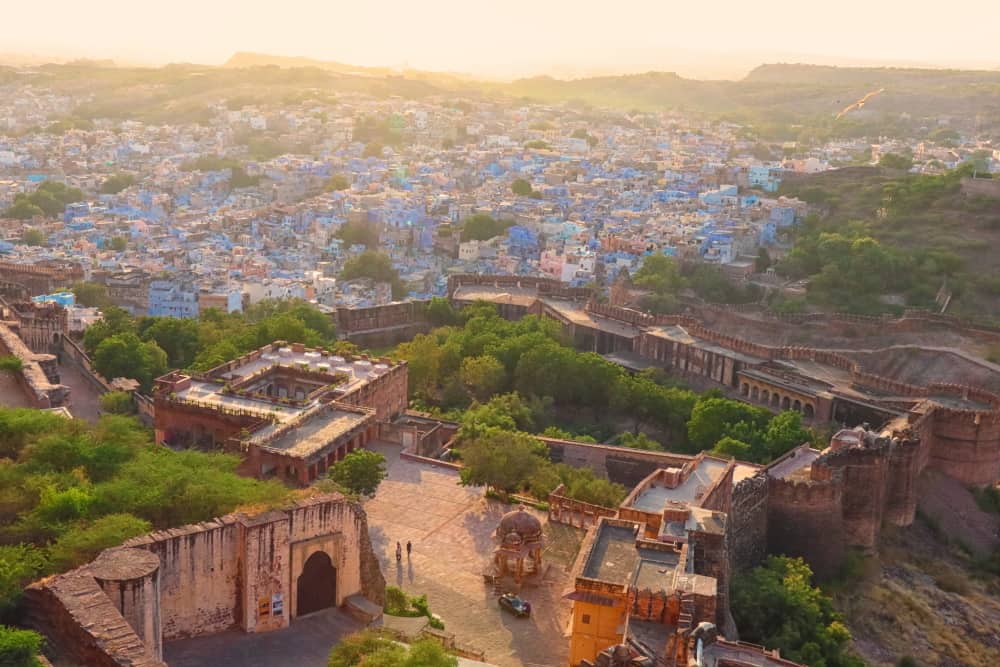
COVID-19 advisory
- Online booking of the entry ticket is encouraged.
- Face-mask is mandatory for all visitors.
- Temperature check is mandatory for all visitors.
- Maintain social distancing, and the same will be enforced when needed.
- No outside F&B and no bag is allowed inside.
- Digital payment is encouraged during entry on-spot.
- Wash/sanitise hands frequently. Multiple hand-sanitising units are stationed inside the fort premises.
- Do not touch showcases in the museum.
More Interesting Facts about Mehrangarh Fort
- Mehrangarh Fort is a UNESCO world heritage site.
- The Fort has been declared a National Geological Monument by GSI (Geological Survey of India) because of the rocky hill on which the fort stands. It represents the last phase of igneous activity in the Indian subcontinent.
- Many movies were shot in Mehrangarh Fort. Some are The Jungle Book (1994) and The Dark Knight Rises (2012).
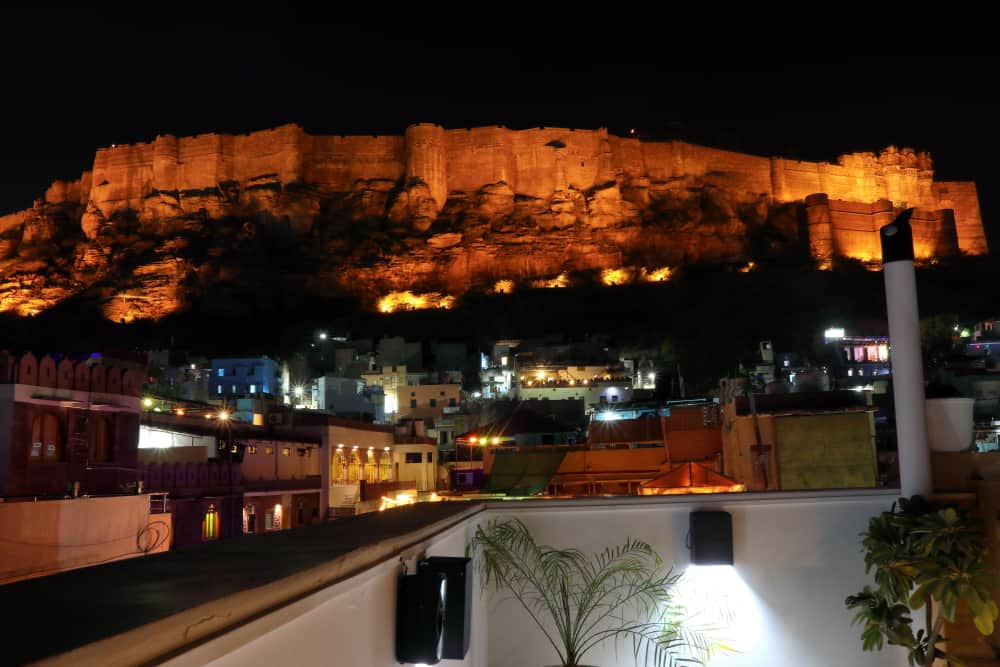
Pin to read later!!
Do you have a Pinterest account? If yes, then you can pin these images and save the link to this article.


Book your trip: Resources
- Flight
Use Skyscanner or Google Flights to book your flight.
- Accommodation
Tripadvisor and Agoda are perfect for booking your hotel. If you want to stay in a hostel, then Hostelworld would greatly help you find one at your convenience.
- Travel Insurance
World Nomads is perfect for travel insurance. You can get comprehensive protection from them. Let them take care of unexpected situations while you concentrate on your trip.
- Package Tour and Activities
You can book a package tour from G-Adventures and Viator. They are a reputed company arranging small group tours and customising them per your requirements. You can also use Get Your Guide to book your private transport, city tours, heritage walks, food walks and other experiences like a cooking lesson or a Yoga session.
Disclosure: Some of the links below are affiliate links. You will be directed to another third-party website when you click those links. If you purchase anything via those links, I will earn a referral bonus without any extra cost to you.
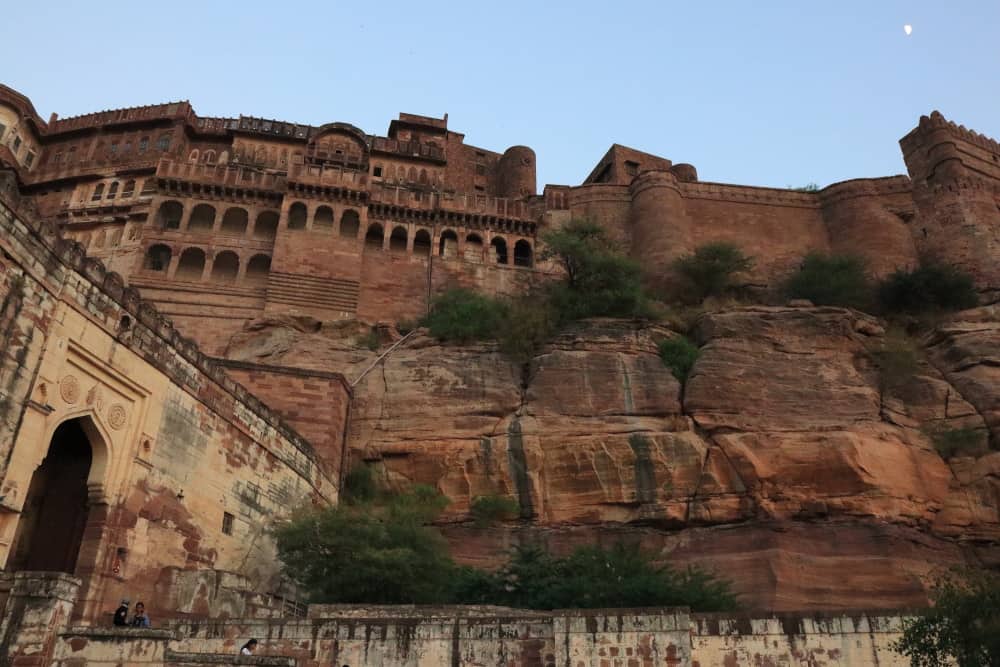
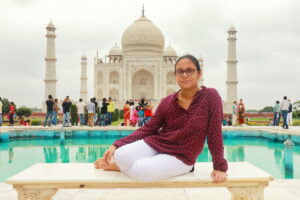
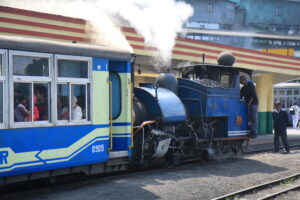
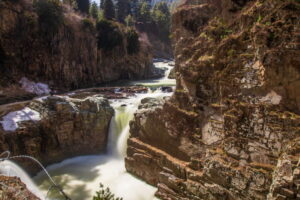
Pingback: An Insight into the Blue City of Jodhpur - My Travel Frames
Pingback: Welcome to Golden Fort in Jaisalmer - The Last Living Fort of India
Pingback: A Perfect One Day in Jaipur Itinerary - My Travel Frames